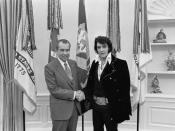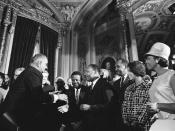Eng 1 Eng � PAGE �4� Eng 3
The Twenty-sixth Amendment
The Twenty-sixth Amendment was proposed March 23, 1971, to lower the voting age from twenty-one to eighteen. It was decisively authorized on July 1, 1971. The official amendment is, "Section 1. The right of citizens of the United States, who are eighteen years of age or older, to vote shall not be denied or abridged by the United States or by any State on account of age. Section 2. The Congress shall have power to enforce this article by appropriate legislation" (Boyer).
The Twenty-sixth amendment was passed quickly to prevent potential problems in the 1972 elections. The urge for lowering the voting age began with the young people who had been drawn into the political world by the Vietnam War. The Congress and the state officials felt escalating pressure to pass the Constitutional amendment because of the war, in which many young men who were unable to vote were enlisted to fight in the war.
Supporters argued that if eighteen-year-olds were old enough to be drafted into military service and sent into combat, they were also old enough to vote. The idea was that they should have a say in the selection of the civilian government that determines when and how the military force is used. "Old enough to fight, old enough to vote," was a common slogan used by advocates for lowering the voting age that traced its roots back to World War II, when President Franklin D. Roosevelt dropped the military draft age to eighteen. The one flaw in the argument was that women were not drafted and were not allowed to serve in combat units if they enlisted in the army. Nonetheless, the momentum of the determination for lowering the voting age increased. In 1970,


